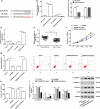Long non-coding RNA NORAD contributes to the proliferation, invasion and EMT progression of prostate cancer via the miR-30a-5p/RAB11A/WNT/β-catenin pathway
- PMID: 33292272
- PMCID: PMC7694907
- DOI: 10.1186/s12935-020-01665-2
Long non-coding RNA NORAD contributes to the proliferation, invasion and EMT progression of prostate cancer via the miR-30a-5p/RAB11A/WNT/β-catenin pathway
Abstract
Background: Prostate cancer (PC) is common male cancer with high mortality worldwide. Emerging evidence demonstrated that long noncoding RNAs (lncRNAs) play critical roles in various type of cancers including PC by serving as competing endogenous RNAs (ceRNAs) to modulate microRNAs (miRNAs). LncRNA activated by DNA damage (NORAD) was found to be upregulated in PC cells, while the detailed function and regulatory mechanism of NORAD in PC progression remains largely unclear.
Methods: Expression of NORAD in PC tissues and cell lines were detected by real-time quantitative PCR (qRT-PCR). NORAD was respectively overexpressed and knocked down by transfection with pcDNA-NORAD and NORAD siRNA into PC-3 and LNCap cells. Cell proliferation, invasion and apoptosis were determined by using CCK-8, Transwell and Flow cytometry assays, respectively. The target correlations between miR-30-5p and NORAD or RAB11A were confirmed by using dual luciferase reporter assay. Moreover, expression levels of RAB11A, the epithelial-mesenchymal transition (EMT) marker proteins and the Wnt pathway related proteins were measured by Western blotting. Tumor xenograft assay was used to study the effect of NORAD on tumor growth in vivo.
Results: NORAD was upregulated in PC tissues and cells. Overexpression of NORAD promoted cell proliferation, invasion, EMT, and inhibited cell apoptosis; while knockdown of NORAD had the opposite effect. NORAD was found to be functioned as a ceRNA to bind and downregulated miR-30a-5p that was downregulated in PC tumor tissues. Rescue experiments revealed that miR-30a-5p could weaken the NORAD-mediated promoting effects on cell proliferation, invasion and EMT. Furthermore, RAB11A that belongs to a member of RAS oncogene family was verified as a target of miR-30a-5p, and reintroduction of RAB11A attenuated the effects of miR-30a-5p overexpression on cell proliferation, invasion, EMT and apoptosis of PC cells. More importantly, silencing RAB11A partially reversed the promoting effects of NORAD overexpression on cell proliferation, invasion and EMT of PC cells via the WNT/β-catenin pathway. Lastly, tumorigenicity assay in vivo demonstrated that NORAD increased tumor volume and weight via miR-30a-5p /RAB11A pathway.
Conclusion: Our results indicated a significant role of NORAD in mechanisms associated with PC progression. NORAD promoted cell proliferation, invasion and EMT via the miR-30a-5p/RAB11A/WNT/β-catenin pathway, thus inducing PC tumor growth.
Keywords: Apoptosis; Epithelial–mesenchymal transition; Proliferation; Prostate cancer; RAB11A; Wnt/β-catenin; lncRNA NORAD; miR-30a-5p.
Conflict of interest statement
The authors declare that they have no competing interests.
Figures







Similar articles
-
Non-coding RNA Activated by DNA Damage: Review of Its Roles in the Carcinogenesis.Front Cell Dev Biol. 2021 Aug 13;9:714787. doi: 10.3389/fcell.2021.714787. eCollection 2021. Front Cell Dev Biol. 2021. PMID: 34485302 Free PMC article. Review.
-
Long noncoding RNA NORAD regulates lung cancer cell proliferation, apoptosis, migration, and invasion by the miR-30a-5p/ADAM19 axis.Int J Clin Exp Pathol. 2020 Jan 1;13(1):1-13. eCollection 2020. Int J Clin Exp Pathol. 2020. PMID: 32055266 Free PMC article.
-
Long non-coding RNA NORAD protects against cerebral ischemia/reperfusion injury induced brain damage, cell apoptosis, oxidative stress and inflammation by regulating miR-30a-5p/YWHAG.Bioengineered. 2021 Dec;12(2):9174-9188. doi: 10.1080/21655979.2021.1995115. Bioengineered. 2021. PMID: 34709972 Free PMC article.
-
The Long Noncoding RNA NEAT1 Targets miR-34a-5p and Drives Nasopharyngeal Carcinoma Progression via Wnt/β-Catenin Signaling.Yonsei Med J. 2019 Apr;60(4):336-345. doi: 10.3349/ymj.2019.60.4.336. Yonsei Med J. 2019. PMID: 30900419 Free PMC article.
-
Interplay between lncRNA/miRNA and Wnt/ß-catenin signaling in brain cancer tumorigenesis.EXCLI J. 2023 Nov 28;22:1211-1222. doi: 10.17179/excli2023-6490. eCollection 2023. EXCLI J. 2023. PMID: 38204968 Free PMC article. Review.
Cited by
-
Oxidative Stress and Inflammation in Cardiovascular Diseases and Cancer: Role of Non-coding RNAs.Yale J Biol Med. 2022 Mar 31;95(1):129-152. eCollection 2022 Mar. Yale J Biol Med. 2022. PMID: 35370493 Free PMC article. Review.
-
Non-coding RNA Activated by DNA Damage: Review of Its Roles in the Carcinogenesis.Front Cell Dev Biol. 2021 Aug 13;9:714787. doi: 10.3389/fcell.2021.714787. eCollection 2021. Front Cell Dev Biol. 2021. PMID: 34485302 Free PMC article. Review.
-
Absence of Scaffold Protein Tks4 Disrupts Several Signaling Pathways in Colon Cancer Cells.Int J Mol Sci. 2023 Jan 9;24(2):1310. doi: 10.3390/ijms24021310. Int J Mol Sci. 2023. PMID: 36674824 Free PMC article.
-
Epithelial-Mesenchymal Transition Signaling and Prostate Cancer Stem Cells: Emerging Biomarkers and Opportunities for Precision Therapeutics.Genes (Basel). 2021 Nov 27;12(12):1900. doi: 10.3390/genes12121900. Genes (Basel). 2021. PMID: 34946849 Free PMC article. Review.
-
The role of long non-coding RNA NORAD in digestive system tumors.Noncoding RNA Res. 2024 Sep 2;10:55-62. doi: 10.1016/j.ncrna.2024.09.002. eCollection 2025 Feb. Noncoding RNA Res. 2024. PMID: 39296642 Free PMC article. Review.
References
-
- Davidsson S, Andren O, Ohlson AL, Carlsson J, Andersson SO, Giunchi F, Rider JR, Fiorentino M. FOXP3(+) regulatory T cells in normal prostate tissue, postatrophic hyperplasia, prostatic intraepithelial neoplasia, and tumor histological lesions in men with and without prostate cancer. Prostate. 2018;78(1):40–47. doi: 10.1002/pros.23442. - DOI - PMC - PubMed
LinkOut - more resources
Full Text Sources

